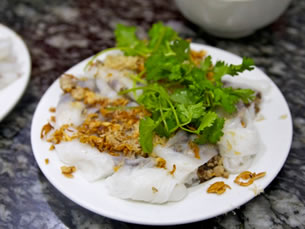by Vincent Esnoul

The Vietnamese cuisine is very rich and diverse with some 500 national dishes. It is also popular for being healthy, cheap, and fine at the same time. Vietnamese dishes often include a combination of rice, fish sauce, herbs, spice, fresh (and sometimes raw) vegetables and a source of protein. A traditional Vietnamese meal will include a bowl of steamed rice, and some grilled fish or stewed meat.
Many small shops dot the streets and it is possible to eat very cheaply on the sidewalk, sitting on a small stool.
All the dishes are brought at the same time on the table and are shared by everyone at the table. In the menus, there is always meat and fish, it is the principle of Yin and Yang.
It is quite rare to find sweet desserts in the restaurant menus. The Vietnamese dessert is usually composed of fresh fruits. The most common are pineapple, banana, orange and papaya. Other exotic fruits can be offered as well: mango, mangosteen, rambutan, longan, jackfruit, durian.
This is the national drink. It is often offered free in restaurants and cafes or at a ridiculously cheap price. The most common is green tea served in small porcelain cups.
Beer has become very popular and cheap in Vietnam. You can find restaurants serving bia hơi, a beer brewed locally. Saigon, Tiger, 333 (Ba-ba-ba), Larue or Bivina are most well-known brands available in Vietnam.
Vietnam is the world's second largest producer of coffee after Brazil. Coffee is a widespread popular drink in Vietnam, especially the cà phê đá or cafe da, a traditional Vietnamese iced coffee. Also, a growing number of western-style restaurants, cafes and bars serve all kinds of coffees, including espresso and cappuccino.
More information about Vietnamese food (and source of the photo)
http://www.seriouseats.com/2013/01/vietnamese-dishes-foods-you-should-know-hanoi-saigon-pho-banh-mi.html
Writing systems | Language and languages | Language learning | Pronunciation | Learning vocabulary | Language acquisition | Motivation and reasons to learn languages | Arabic | Basque | Celtic languages | Chinese | English | Esperanto | French | German | Greek | Hebrew | Indonesian | Italian | Japanese | Korean | Latin | Portuguese | Russian | Sign Languages | Spanish | Swedish | Other languages | Minority and endangered languages | Constructed languages (conlangs) | Reviews of language courses and books | Language learning apps | Teaching languages | Languages and careers | Being and becoming bilingual | Language and culture | Language development and disorders | Translation and interpreting | Multilingual websites, databases and coding | History | Travel | Food | Other topics | Spoof articles | How to submit an article
[top]
You can support this site by Buying Me A Coffee, and if you like what you see on this page, you can use the buttons below to share it with people you know.

If you like this site and find it useful, you can support it by making a donation via PayPal or Patreon, or by contributing in other ways. Omniglot is how I make my living.
Note: all links on this site to Amazon.com, Amazon.co.uk
and Amazon.fr
are affiliate links. This means I earn a commission if you click on any of them and buy something. So by clicking on these links you can help to support this site.
[top]